R.M. (Matt) Joeckel, Director 2014-present
Dr. Joeckel first joined the Conservation and Survey Division (Nebraska Geological Survey) in August 2000 and began administering CSD as State Geologist and Associate Director for Conservation and Survey in the School of Natural Resources in 2014.
He holds a B.S. and an M.S. in geology from UN-L and he also attended the University of Kansas and the University of Florida. He received his Ph.D. in geology from the University of Iowa in 1993, and engaged in in coursework in soils at Iowa State University through a student exchange program. In 1994-1996, he was a postdoctoral fellow in the Department of Earth and Planetary Sciences at the University of Tennessee-Knoxville.
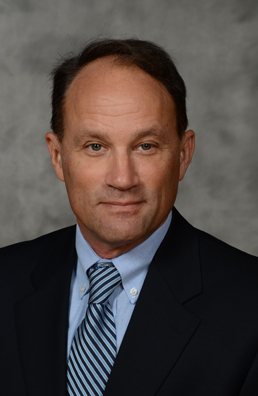
Mark S. Kuzila, Director 1998-2014
Mark Kuzila earned his BS (1973) and MS (1976) from Kansas State University and his PhD in 1988 from the University of Nebraska.
Dr. Kuzila started with CSD in July 1975 as a soil scientist on a soil survey crew in Madison and Stanton counties. He moved to Lincoln in 1979 to serve as Assistant Principal Soil Scientist and to work on the statewide Nebraska Cooperative Soil Survey Project. He became Principal Soil Scientist in 1983 and continued in that role until he was appointed Director in 1998. His background in pedology and statewide experience with soils and surficial geology has given him a great respect for Nebraska's earth resources. That foundation leads him to a strong interest in leading CSD to fulfill its geological survey mission to the citizens of Nebraska by applying earth resource research and data to the needs of the state.
In 2003, CSD merged with the School of Natural Resource Sciences to become the new School of Natural Resources (SNR). From 2003 to 2007, Dr. Kuzila served as both the director of SNR and CSD. On August 1, 2007, Dr. Kuzila stepped down as director of SNR, but continued as director of CSD. He remained director until he stepped down on July 1, 2014.
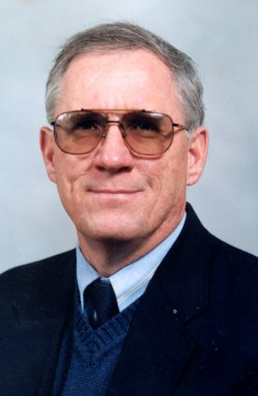
Perry B. Wigley, Director 1987-1998
Dr. Perry B. Wigley was born January 24, 1941. He received his bachelor's degree from Birmingham-Southern College in 1963, his master's in 1965, and his Ph.D. in 1968 from Virginia Polytechnic Institute.
Dr. Wigley came to the division from the position of exploration manager--onshore North America with Texas Eastern Exploration Company, of Houston, Texas. His credentials included assistant director (program manager) with the Georgia Geological Survey, and professor of geology, Eastern Kentucky University.
Perry B. Wigley 1941-2003
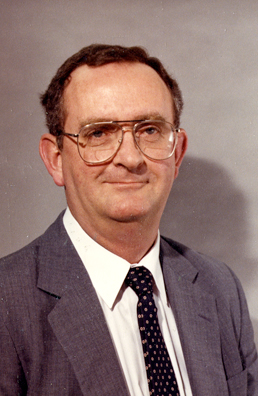
Vincent H. Dreeszen, Director 1967-1987
Vincent H. Dreeszen became acting director upon the retirement of E.C. Reed in 1967, and was appointed director by the regents two years later.
Dreeszen was born at Palmyra, Nebraska, July 23, 1921. He received his bachelor's degree at Peru State Teachers College in 1942 before entering the navy. Returning to Nebraska after the war, he worked part time for the division and completed his graduate studies at the university in 1949, the same year he joined the division as a geologist-hydrologist. Named assistant director in 1959, Dreeszen continued shepherding the test-drilling program and studying his principal interests, the Cenozoic rocks of Nebraska and their critical importance to the water supplies of the state. On becoming director, he gradually expanded the scope and scale of the Conservation and Survey Division to more nearly coincide with the provisions of the 1921 act, especially with regard to the survey of water and land resources. The geological survey, while still emphasizing applied geology and relying strongly on subsurface techniques, was enlarged and broadened.
The basic statutes pertaining to the division have been changed little since 1921, but an increase in the size and complexity of the university, coincident with the expansion of the division, has altered the ruling bureaucracy. Until 1959 the Conservation and Survey Division legislative appropriation was an individual item in the university budget and the director of the division reported to the chancellor of the university. A three-fold university system with a president over three chancellors emerged in 1968 after the state acquired the University of Omaha. At this time, the Conservation and Survey Division became part of the University of Nebraska-Lincoln and the director of the division reported to the chancellor of the university. An individual legislative appropriation to the division within the university appropriation continued until 1973.
In that year, reorganization of the University of Nebraska-Lincoln placed the division within the Institute of Agriculture and Natural Resources (IANR), headed by a vice-chancellor, and the division's appropriation became a part of the Institute's budget. Thus, a division with an already long and ambiguous name became further ladened with titles of epic proportions that, everything considered, still did not reflect all of the complexity of the administrative superstructure. Throughout these and other changes, however, a state geological survey continued, and, today, carried forward a tradition 115 years old.
Dreeszen served the division under Condra and Reed and knew Barbour and his work. Each of these leaders over a more than 95-year span established for the survey a statewide and national reputation for scientific credibility and achievements. The record of public service to the state established during their tenure is one of strong influence on public decisions in matters related to natural resource utilization and management. Vincent Dreeszen stepped down as director March 1, 1987.
Vincent H. Dreeszen 1921-2006
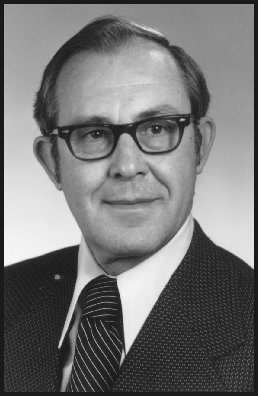
Eugene C. Reed, Director 1954-1967
Eugene C. Reed was born in Holdrege, Nebraska, December 12, 1901. He acquired his bachelor's degree at the University of Nebraska in 1923, then spent the next eight years as a petroleum geologist in Mexico and Venezuela. Returning to Nebraska, he completed his graduate studies in 1933 and joined the Conservation and Survey Division as a geologist. Becoming Associate Director in 1944, he toiled at the survey during Condra's declining years before being named Director in 1954, sans Condra's title of dean.
Reed is the principal figure in the transition from the old surveys to the modern organization. A first-hand observer of the debilitating effects of the Great Depression and World War II on state institutions in general and state geological surveys in particular, Reed, along with Condra, stressed the importance of cooperative work with the USGS in order to get something accomplished in Nebraska.
This cooperation was particularly critical for groundwater surveys and the monitoring of groundwater resources. After World War II, Reed, with the help of a young Vincent H. Dreeszen, devised a systematic, long-term drilling program for investigating these groundwater resources and the significant post-Cretaceous deposits of the state in cooperation with the federal survey. This program, which at an early date applied some oil-field technologies to groundwater investigations, continues today and is a large source of information for one of Nebraska's most important resources.
Reed's experience as a petroleum geologist served the division and state well because oil strikes were made near Falls City in southeast Nebraska in 1939, north of Sidney in the Panhandle in 1949, and near McCook in southwest Nebraska in 1959. As he was for years the only public geologist with significant experience in this field, Reed became the focal point for both industry and public interests. The state geologist was given the assignment of overseeing some of the activities of the petroleum industry in the state in 1941, and his powers were broadened in 1951. Reed felt that the leading institution of higher learning and public research in the state should not be simultaneously a regulatory agency so, after becoming director, he helped create the Nebraska Oil and Gas Conservation Commission in 1959. He had by this time, however, added more geologists to the division staff in order make use of the information that was accumulating from both the petroleum industry and the cooperative test-drilling program.
The 1921 act that established the Conservation and Survey Division created, on paper, a grandiose organization for surveying natural resources. The depression, war and flagging energy of the aging Condra, in fact, prevented realization of this kind of organization. When Reed became director in 1954, the division had a very small professional staff working primarily with groundwater resources and stratigraphy and a loosely associated group of individuals from other parts of the university and federal agencies. Reed increased the geological staff, especially those mapping the deeper subsurface features, and, during his tenure from 1954-1967, the Conservation and Survey Division probably acquired an identity more nearly akin to a geological survey than to a broadly-arrayed natural resources survey. Applied geology, utilizing subsurface information and techniques, set the general tone of the division.
Eugene C. Reed, 1901-1976
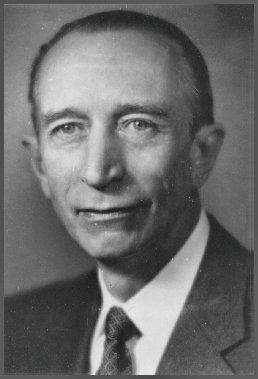
George E. Condra, Director 1921-1954
The big, bull-voiced athlete joined the university faculty in 1902 and began espousing resource conservation, a popular national movement of the early twentieth century. On this issue Condra became to Nebraska what Theodore Roosevelt was to America, a highly visible public figure leading a cause.
Invited to a 1907 governors' conference on conservation called by Roosevelt, Condra returned from Washington and set to work. The year 1908 was a year of recess for the biennial legislature, but Governor Sheldon, on his own initiative, created a Nebraska Conservation Commission. The following year the legislature appropriated $1,000 for the commission and required that it be spent by Condra as director of the Conservation and Soil Survey under the control of the regents. In 1911, the indirect appropriation for the fledgling survey was 60 percent of the magnanimous state geological survey appropriation of that year. Finally, in 1913, the legislature created the Conservation and Public Welfare Commission with a membership consisting of the governor, the chancellor of the university, the director of the Conservation and Soil Survey, and two additional state officials.
One of the principal duties of the commission was to "serve as an advisory board for the various state surveys."* This meant that Condra was one of five advising himself and Barbour. During the same session, legislation was enacted to formalize the existence of the Conservation and Soil Survey within the university and to define its work. One of the duties was to survey the natural resources of the state with the following resources being outlined by statute: soil, water, water power, potash, forest, and road materials. The biennial appropriation for Condra's survey doubled to $12,000 while Barbour's survey received $10,000, the same amount that was voted in 1911.
A clear and probably covert rivalry had developed between the two men and their surveys. Barbour, long a prominent figure at the university, had other duties to attend to in the geology department and the museum. Condra could cultivate his single crop. If biennial appropriations are a guide, then Condra clearly gained the upper hand in 1915 when his appropriations remained constant at $12,000 while the geological survey's dropped to $7,500. Two years later, the Conservation and Soil Survey appropriations grew to $25,000 while the geological survey received nothing.
Barbour continued to be state geologist, but by now there was no longer an effectual state geological survey. The legislature in 1919 ended the rivalry, for all practical purposes, by enlarging the duties of the Conservation and Soil Survey to include some geological activities while not calling these activities geological, by again appropriating $25,000 to this survey, by ignoring the state geological survey, and by discontinuing the Conservation and Public Welfare Commission.
The final act of this stage of evolution of the modern Nebraska Geological Survey was written in 1921. Legislation was passed that did away with the Conservation and Soil Survey but which created a new, broad-based organization within the university, the Conservation and Survey Division. Among a wide range of other things, the law specified that the division would include a geological survey, that the chief or director of the division would be appointed by the regents, that expenses incurred in carrying out the act would be subject to the approval of the regents and paid out of appropriations made by the legislature, that the division could enter into agreements with federal departments with the approval of the regents, and that the 1913 law which provided for the appointment of a state geologist be repealed. An official state geologist thus no longer existed, although Barbour had filled this fundamentally empty position from 1917 to 1921. In place of a person, there was an official state geological survey firmly established by law. And Condra was head of that survey. Whether Condra stole the geological survey from Barbour or whether the former athlete accepted it by default can only be known by those who were an intimate part of this evolutionary change.
Erwin H. Barbour and George E. Condra loom as the two greatest figures in the history of Nebraska geology and they cast long shadows. Both were of statewide renown by 1921, and both would linger at the university for years, pacing known territory but never venturing too far into new fields. Barbour continued as head of the geology department until 1934 and as director of the state museum until 1941. From 1919 to 1929, he also served as chairman of the geography department. Acquiring the additional title of dean in 1929, Condra continued as director of his survey until 1954.
Few scientists trained today have had the opportunities to absorb knowledge in so many natural resource fields as did Condra. He was well-informed in the fields of botany, zoology, chemistry, forestry, geography, conservation and wildlife, as well as in geology, mineralogy, paleontology and hydrology. He was one of the first to recognize the tremendous opportunity for the use of groundwater and water from streams to supplement agricultural production. He helped organize the Nebraska Well Drillers Association in 1929 to encourage professionalism, the sharing of ideas, and most importantly, sanitary well conditions.
*Addision E. Sheldon, editor, Nebraska Blue Book and Historical Register, 1918.
George E. Condra, 1869-1956
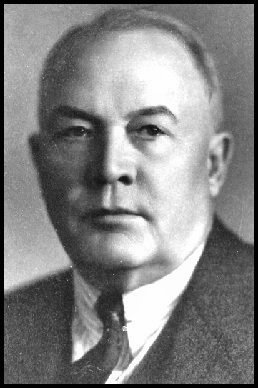
Erwin H. Barbour, Director 1891-1921
Barbour came to Nebraska with credentials--a Ph.D. from Yale, where O.C. Marsh and J.D. Dana were two of his teachers, field experience with the United States Geological Survey (USGS), and two years teaching at Grinnell College.
Although his principal interest was vertebrate paleontology, Barbour recognized the commercial importance of geology and the rudiments of a state geological survey slowly assumed shape. Governor Thayer had appointed Barbour acting state geologist the year he arrived, and in 1893 legislation was enacted that made the head professor of geology at the university, i.e. Barbour, the geologist for the state. Formal appointment to what amounted to the position of Director of the State Museum also came to Barbour in 1893, so leadership in public geology was officially concentrated in the head of the geology department of the university.
The state was free with titles in 1893 but free with little else. No money was designated for the geological survey by either the regents or the Legislature, but Barbour did conduct some field work at his own expense in 1891 and 1892. In 1893, Regent Charles H. Morrill, who also was interested in paleontology, began financing expeditions to collect fossils and other geologic samples and continued to do so until 1902. Information was at last being obtained on a systematic basis with private money.
Public funds for the state geological survey became available in 1889 when the regents provided for $500 for this purpose from the University budget. These funds were decreased to $250 for the years 1900, 1901 and 1902. The first direct state aid to the survey came in 1901 when $1,200 was appropriated by the Legislature for the 1901-02 biennium and probably provided funds for the first publications of the geological survey in 1903. Slightly larger biennial sums were voted until 1911 when legislation was padded that enabled the state survey to cooperate with the USGS. That year, the part of the general appropriation bill referring to the state survey was worded as follows:
For publishing reports of the Geological Survey of Nebraska, and for co-operation with the United States Geological Survey, ten thousand dollars, said money to be expended under the direction of the Board of Regents and the State University.
After twenty years of labor, Barbour appeared to have established a stable geological survey with a financial base. Appearances are deceptive, however, because the same legislature passed two bills that must have shaken Barbour's confidence in the future of the state geological survey as it was then organized. One was an act that empowered "the regents to appoint a member of the teaching staff to be state geologist," a significant departure from the 1893 act which automatically made the head of the department the state geologist. The other was an appropriation of $6,000 for another ad hoc university unit with the unwieldy name of Nebraska Conservation and Soil Survey.
One cannot decide at this date whether or not the 1911 legislature was signaling coming changes for the state geological survey, but changes there were in the ensuing decade. Most of them centered about the Conservation and Soil Survey and its dynamic director, George E. Condra, the second source of the modern Nebraska Geological Survey and the progenitor of the Conservation and Survey Division.
Erwin H. Barbour 1856-1947
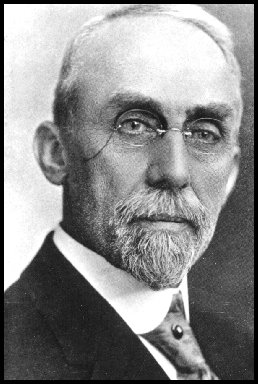
Lewis E. Hicks, Director 1884-1891
Lewis E. Hicks joined the faculty the following year as professor of geology and apparently was given the honorary geological title that Samuel Aughey had held. A student of Louis Agassiz, Hicks was more than a teacher and academic. Like Aughey, he was a practical scientist concerned about the development of the natural resources. Critical of the federal policy of spending money to investigate only surface water resources, Hicks became an early advocate of the need for surveying groundwater resources and for using groundwater to irrigate crops. Robert N. Manley, in his Centennial History of the University of Nebraska, I. Frontier University (1869-1919), states that it was from Hicks' investigation in the late 1880s that "...the people of Nebraska learned of the great water resources in the state" and that "...as both a scientist and a promoter of irrigation, Professor Hicks deserves the gratitude of Nebraskans."
A "wave of resignations hit the University" in 1892, according to Manley, presumably because other institutions were offering Nebraska professors more pay and better teaching conditions. Manley includes Hicks in his list of notable professors departing that year. In 1891, another geologist, Edwin H. Barbour, had arrived at the university and, hurrying on his way to Nebraska fame, became head professor of geology and acting state geologist the year he arrived. One might speculate that the status of the new arrival and the generally unsatisfactory conditions at the university were reasons enough for Hicks to leave after eight years of service. Whatever the circumstances, by 1892, Barbour was in command and Hicks was gone.
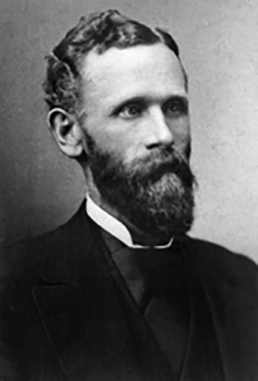
Samuel Aughey, Director 1871-1883
In the year 1871, Samuel H. Aughey, a Lutheran minister and natural scientist operating independently in Nebraska since 1864, was appointed by the regents to a chair of natural history at the new university. The only scientist on a faculty of five, Aughey somehow acquired the title "Honorary State Geologist" at the same time. The title carried no stipend and presumably provided the practical-minded people of Nebraska a focal point for public and private questions about geological resources while at the same time saving the state a considerable amount of money.
Possibly the most noted member of the university faculty during the 1870s, Aughey probably toiled harder for the people of the state than for his students, and he became a well-known Nebraska booster.
He promoted the richness of the state's soils, the idea of increasing precipitation by cultivating more acres, and the prospects for coal for fuel in this state of few trees.
Aughey resigned in August 1883, because the regents apparently were dissatisfied with the amount of time he spent in the Wyoming Territory investigating coal deposits. Rumor and the press suggested Aughey's resignation was due to his issuing a paper with forged endorsements, but an investigation in November of 1883 exonerated him. The regents asked Aughey to withdraw his resignation, but he refused and migrated to the Wyoming Territory.
Samuel Aughey 1831-1912
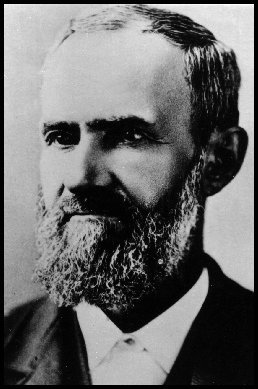
Credits
- Principal text by Vernon L. Souders, Retired Research Geologist
- Additional text by Marjorie Reid, Retired Administrative Assistant, CSD
- Other Miscellaneous Sources